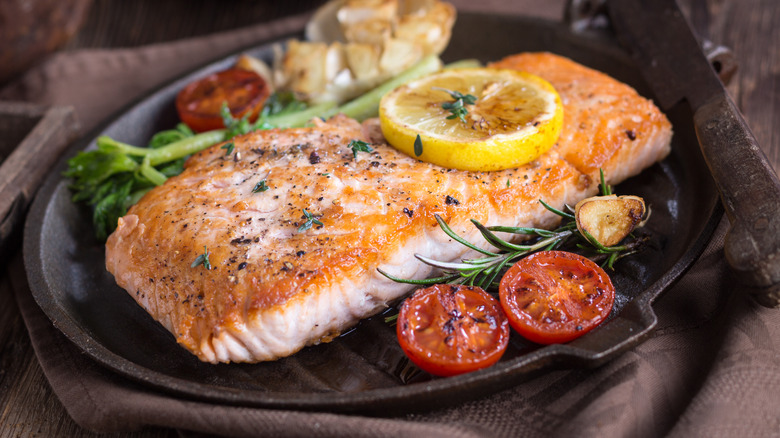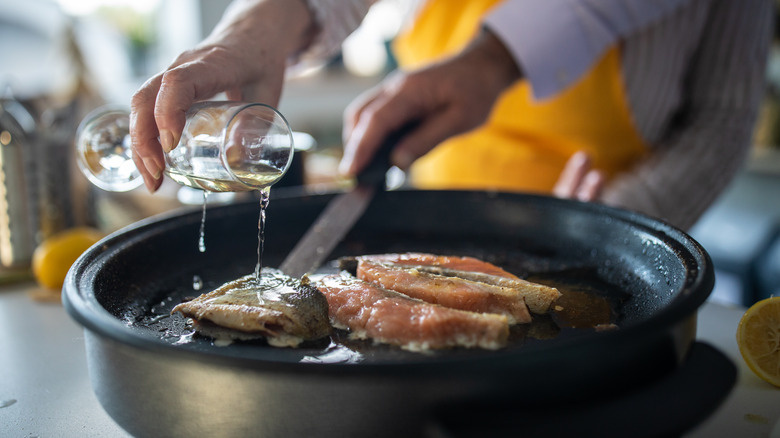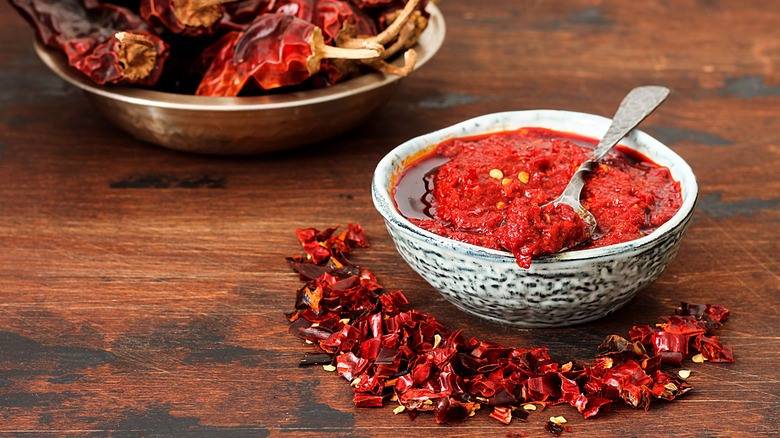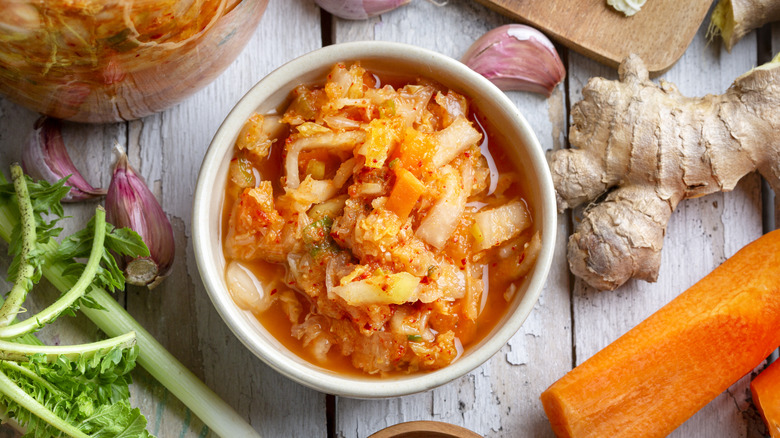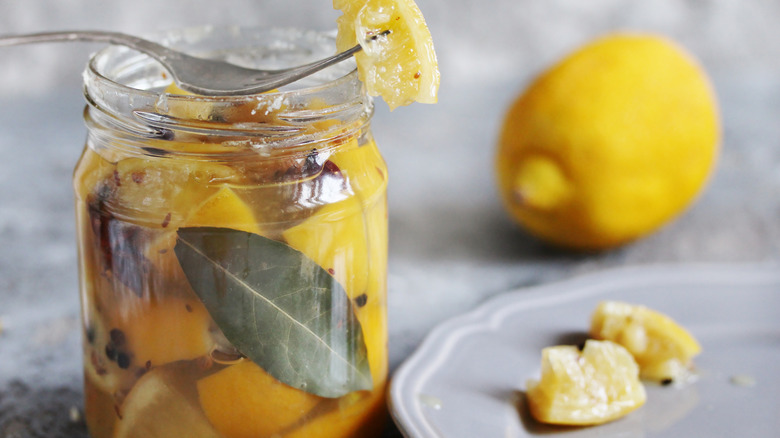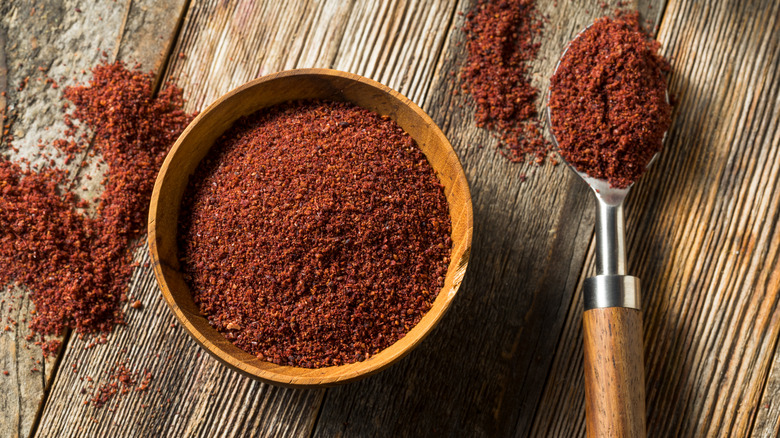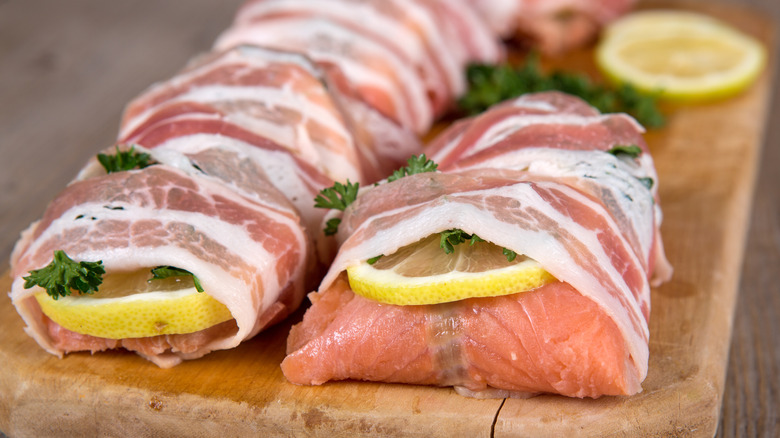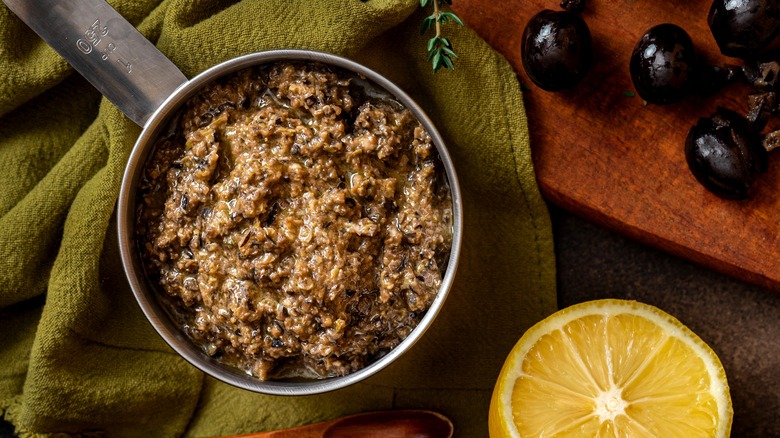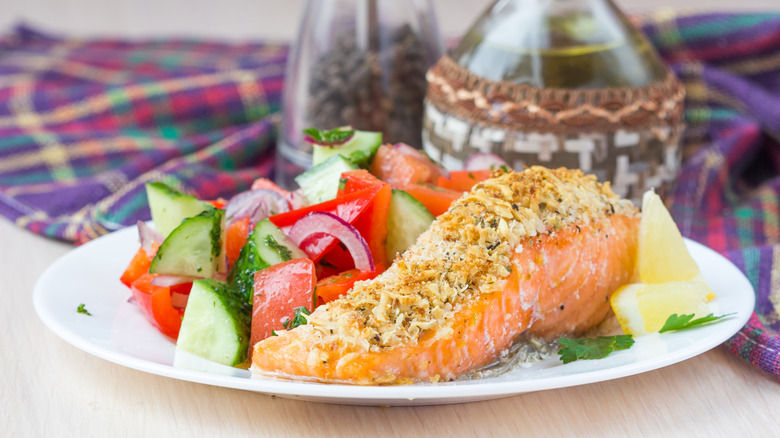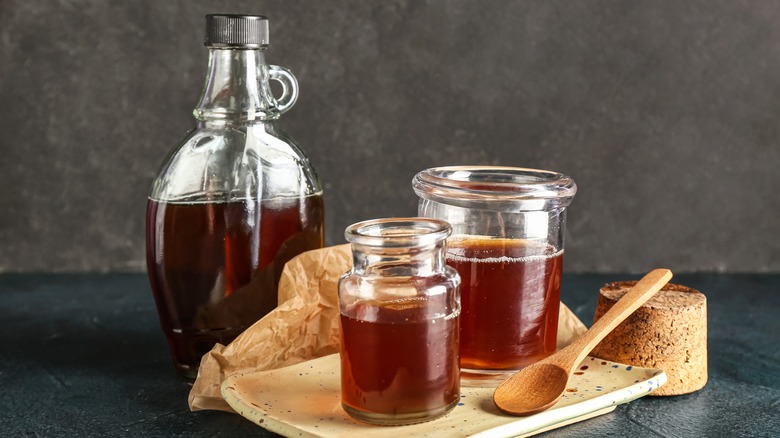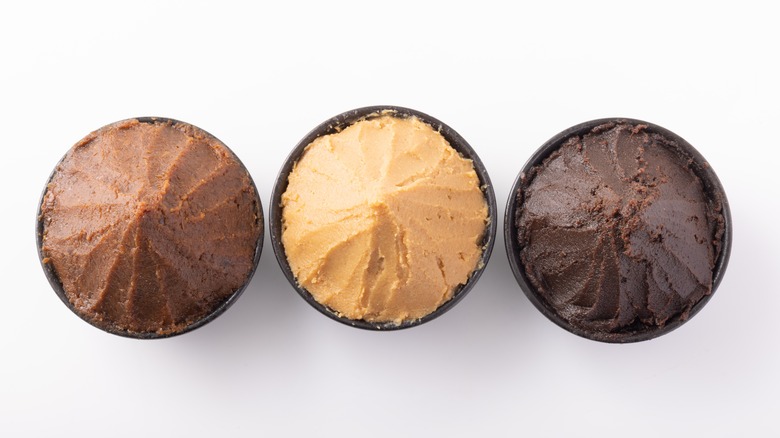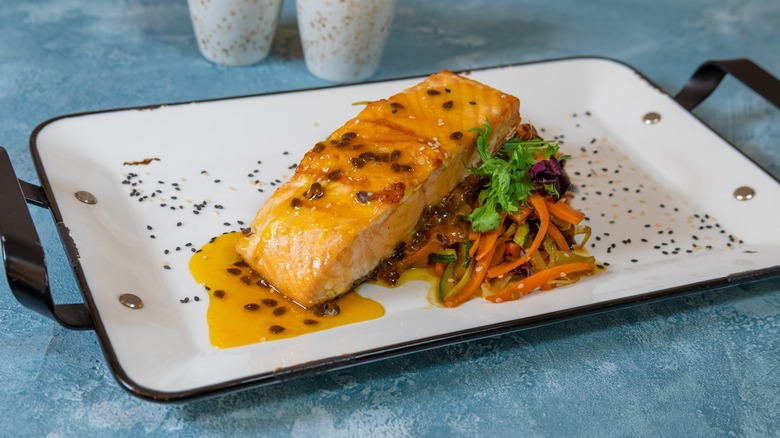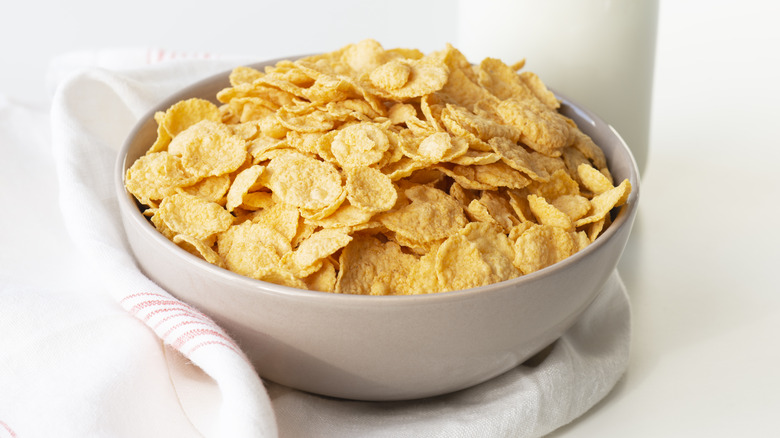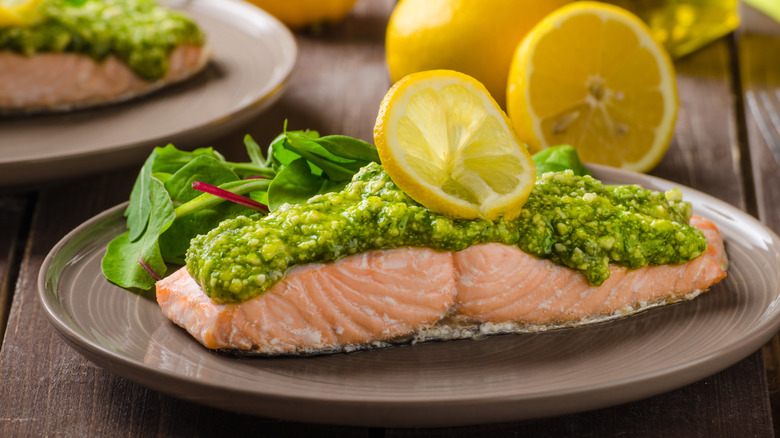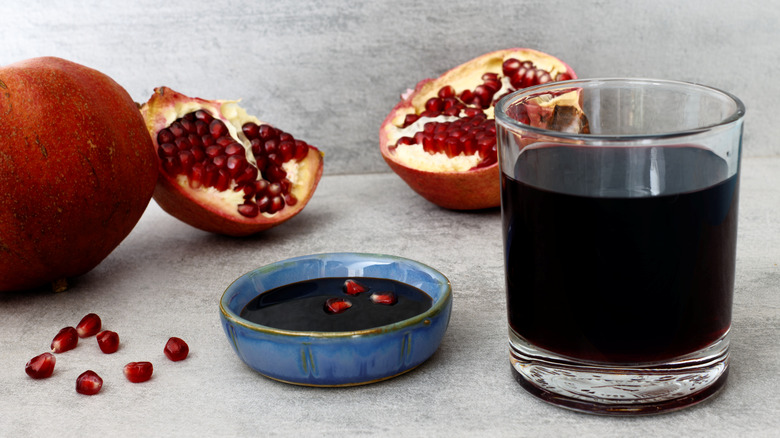14 Unexpected Ingredients To Boost Your Salmon Game, According To A Chef
Among the foods we all should be eating more of is salmon. This nutritional powerhouse is loaded with omega-3 fatty acids, vitamins, and minerals linked with numerous health benefits, including improved cardiovascular health, anti-inflammatory properties, and cognitive well-being. It is also a more sustainable choice when compared with many other types of animal protein.
That's a lot to love, but salmon has more going for it. It is also one of the most versatile fish to prepare. Its distinctive rosy hue, pleasant aroma, flaky texture, and nuanced flavor make it popular with consumers and chefs. In my nearly 18 years as the chef and owner of a fine dining restaurant, salmon was the fish that most frequently appeared on my menu. Its flesh is firm enough to withstand many different cooking methods, from grilling to poaching to pan-searing to baking, and it readily complements seasonings and preparations inspired by the culinary traditions of cultures across the globe which enjoy salmon.
Whether you are preparing Pacific or Atlantic salmon, many unexpected ingredients can boost your salmon game. Using my experience, expertise, and background in food anthropology, I have compiled some of these for you. Read on to find out what these ingredients are, why I chose them, and how you can incorporate them into your next salmon dinner.
1. Boost flavor with booze
Cooking with alcohol can transform the culinary experience by enhancing aroma and helping to transport fat and water-soluble food molecules to our taste receptors. Alcohol can be incorporated into your salmon cooking game by deglazing the pan for a sauce, marinating, creating a glaze, or infusing a poaching liquid. When it comes to using alcohol with salmon, there are a few tips to keep in mind.
While I am not opposed to drinking red wine with fish, especially a lighter red, I typically avoid it when cooking fish, as it can overpower its color and taste. Opt for an acidic, unoaked white wine, such as a New Zealand sauvignon blanc, which is particularly well suited for cooking salmon, as it tends to have bright citrus notes that beautifully complement fish.
Other good options for cooking salmon include bourbon and tequila. Bourbon lends a spicy, caramel-forward, nutty richness ideal for pan sauces and intensely flavored glazes or marinades. Young blanco tequila has a mild, refreshing taste and distinct citrus notes, perfect for marinades, glazes, and salsas.
2. Spice things up with hot sauce
Hot sauce is more than just a condiment — it's an ingredient that can morph salmon into something truly spectacular. It can infuse dressings, marinades, glazes, salsas, and sauces with heat, acid, and bold flavors. The key is utilizing restraint and selecting a sauce that is more than just an exercise in heat tolerance. You want to accentuate the inherent flavor of salmon, not mask it or mute your capacity to taste anything by overwhelming your tongue and nose with spiciness.
One of my favorite hot sauces to use with salmon is harissa paste. This chili paste from North Africa can be purchased in mild and hot iterations made from red or green chili peppers. Regardless of which you opt for, they are all distinguished by tanginess and robust flavor from aromatics and spices that give this sauce a complex taste.
Another go-to hot sauce is the peculiar-flavored Korean condiment known as gochujang. This sauce, made from fermented rice, soybeans, barley, gochugaru, and salt, differs from other hot sauces because of its umami-rich, fermented, funky flavor. When incorporated into sauces, glazes, or marinades, it can accentuate the richness of salmon, giving it an almost meaty flavor profile.
3. Make it funky with kimchi
Speaking of funk, if you haven't started cooking with kimchi regularly, do so immediately. This spicy condiment from South Korea has seen something of a renaissance. It is generally made by fermenting cabbage and other vegetables with fish sauce, gochugaru, sugar, ginger, and garlic. While recipes may vary, all kimchi is characterized by a tangy, spicy, savory flavor punctuated by a hint of salt and has a delightful crunchy texture.
As with hot sauce, this condiment is ideal as a garnish to help accentuate the taste of any salmon dish and add crunch. That said, don't forget to use it in recipes. It is fabulous when incorporated into relishes, salsas, and sauces, such as a spicy take on a remoulade. It is also delicious when added to salmon fried rice topped with a runny fried egg. My favorite place to sneak it in is salmon cakes or fritters, providing a surprise pop of flavor, texture, and heat in these recipes.
4. Add tang with preserved lemons
Few ingredients tickle my taste buds when cooking just about anything, especially fish and seafood, as preserved lemons. Preserved lemons are a condiment found across North Africa, particularly Morocco, where they're frequently added to tagines and salads.
This method of extending the shelf life of the zesty citrus fruit involves quartering lemons, leaving them attached at one end, stuffing as many as you can into a jar before adding salt and seasonings, and submerging them in juice. Once prepared, the jars are sealed and left to brine in a cool place away from sunlight for six weeks or up to one year.
The resulting condiment lacks the astringency of fresh fruit while retaining the citrus-forward flavor profile, making preserved lemons ideal for use in recipes of all kinds, including salmon dishes. The key to using these is only adding the peels, as the fruit retains too much salt to be edible. Even the peels should be thoroughly rinsed in cold water before you chop them finely and add them to your salad, sauce, salsa, stew, or soup dishes. And a little goes a long way — preserved lemons are potent in flavor, and too much can easily overwhelm other ingredients. When used in moderation, though, the subtle citrus flavor is life-changing.
5. Season it with sumac
A preferred spice of celebrity chef Alton Brown, sumac tops my list of seasonings for cooking salmon. This crimson-hued spice is obtained from the wild sumac flower, which grows across the Mediterranean, particularly in North Africa. Long regarded as valuable for its purported medicinal properties and characteristic color, sumac is especially well suited as a supplement or substitute for citrus in recipes. Its distinctive lemony flavor is frequently used as a garnish. It is also one of the key ingredients in the spice blend za'atar.
When adding sumac to salmon recipes, liberally sprinkle it atop filets before pan-searing, or season kebabs before tossing them on the grill. This will amplify the natural pink flesh of the fish while accentuating its rich flavor. Sumac is also delightful when added to sauces, salsas, chutneys, and glazes. Not only does it confer a bright color, but its acidity tempers sweet ingredients, like honey or maple syrup. Lastly, I am particularly fond of using sumac in rice-based recipes, like a play on paella, pairing salmon with shrimp and other seafood.
6. Bacon makes everything better
Bacon makes everything better, including salmon. The smoky, umami-forward flavor of bacon accentuates the rich, subtle fishiness of salmon while helping to keep it moist during the cooking process — a win-win. The best way to incorporate bacon into your salmon game is to wrap your salmon filets with it. You can then grill or pan-sear it.
Use skinless salmon filets for this process and medium-sliced bacon. You'll want to avoid maple-cured bacon, which can quickly burn before the salmon has cooked. Start by gently rendering some of the fat out of the bacon before encasing your seasoned salmon filets. Once the bacon has been secured, toss it onto your grill or into the pan and cook until crisp and the salmon is done. If the salmon is ready before the bacon, do not fret. The added fat from the bacon will help prevent the salmon from drying out. I recommend serving bacon-wrapped salmon with a sweet and spicy sauce, like a maple sriracha BBQ sauce, to help counteract the fattiness of the bacon and brighten the dish.
7. Treat it with tapenade
A classic Provençal specialty, tapenade is a spread and condiment traditionally made from a combination of olives and capers mixed with anchovies, aromatics, seasonings, and olive oil. The intense, salty, umami-rich sauce can be purchased or made from scratch. Many commercial iterations have adapted the recipe to include other ingredients, including sun-dried tomatoes, roasted peppers, or artichoke hearts. While nothing is wrong with these, I am a purist and enjoy mine with a combination of black and green olives, which provide a more complex flavor and are a tad more visually appealing.
Certainly, tapenade can be used in various sauces or marinades. That said, I find it best when used as a crust for salmon before baking it. Douse your salmon filets with a hint of olive oil and season minimally with salt and pepper before spreading a thin layer of tapenade atop each. Once the salmon bakes to a safe minimum temperature of 145 degrees Fahrenheit, serve the filets with a bright, herbaceous sauce with plenty of acidity, like a pistou.
8. Say cheese
While there is a long-held Italian tradition of avoiding preparing fish or seafood with cheese, the myth that fish and cheese are always a no-go needs to be debunked. Plenty of delectable salmon recipes exist using various kinds of cheese, from parmesan-crusted salmon to broiled or Mediterranean-inspired baked tomato and feta creations. Indeed, cheese has two qualities that make it ideal for pairing with fish: its umami-forward notes and its capacity to create luxurious, creamy sauces that bathe the flaky flesh of salmon while accentuating its inherent richness.
As with many other ingredients I have highlighted here, the key to using cheese with salmon is to be cautious and select varieties that are not overly aggressive in flavor, which can easily overwhelm the salmon. I also recommend incorporating an element of acidity to help balance the richness of cheese with the fish. Favorite dishes include creating a salmon salad and turning it into a melt, adding salmon to a baked mac and cheese recipe, and tossing some salmon into a quesadilla, served with guacamole and a bright, spicy pico de gallo.
9. Sweeten it with maple syrup
Maple syrup is a common ingredient to top sweet breakfasts, like pancakes, waffles, and French toast, but its utility doesn't end with the first meal of the day. It can brilliantly elevate sauces, glazes, and marinades of all kinds with its complex flavor and color. The secret to its success lies in the intricacy with which maple syrup is produced. Pure maple syrup isn't just sweet. It has nuttiness, butteriness, and even earthy notes conferred by the terroir within which the maple trees that are tapped for the syrup grow.
Maple syrup comes in different hues, from golden to very dark. Each becomes more intense and complex in flavor, giving it incredible versatility in the kitchen. I opt for darker-colored Grade A maple syrup when pairing it with salmon. Its flavor profile tends to lend itself to sweet and savory combinations. I also make sure to pair it with elements of heat, tang, and umami-forward ingredients, like sriracha, Dijon mustard, and Worcestershire sauce, to give it complexity and appeal to every taste receptor in your mouth.
10. Glaze it with miso
Miso is a fermented soybean paste made from rice, barley, soy, or a combination thereof. It originated in China but was popularized in Japan. Once injected with the koji fungus, steamed soybeans, rice, or barley are left to ferment for various periods, producing miso of different colors and flavors.
When deciding which miso to use in a recipe for a soup, sauce, stew, glaze, dressing, or marinade, it is crucial to understand the flavor profiles of each type. White miso is the mildest, with a sweeter flavor profile and less salty, savory, complex notes. Red miso is aged the longest, developing a darker hue and more robust flavor profile that is intensely salty and savory. For a middle-of-the-road miso, opt for the yellow variety. It has slightly more tang than red miso but is saltier than white. Mixed miso combines the best of all worlds.
Generally speaking, white miso is the most well suited to salmon dishes, as it is less likely to overpower the flaky fish. That said, if you plan to stew your fish or add it to a soup where the miso can mellow, red miso may be the way to go.
11. Get fruity with it
The benefits of incorporating fresh or dried fruits into salmon recipes may be familiar to you if you have eaten ceviche or fish with fruit salsa. Fruit not only provides sweetness to contrast heat and salinity in savory recipes, but it can add acidity and texture and enhance the complexity of salmon dishes.
While salmon is not a fish ideally suited for ceviche, there are plenty of other places where fruit can be used. One of my favorite salmon recipes is a tangy yet spicy mango chutney that contains dried cranberries and pistachios. This is perfectly served atop grilled or pan-seared salmon seasoned with sumac and smoked sea salt. Another combination that was a hit during an Italian-themed dinner I served several years ago was a whole-baked salmon filet with white wine and red grape sauce. Lastly, don't be afraid to use fruit preserves to create a sweet and savory glaze to brush over salmon filets before baking them. Again, balance is the key, with plenty of acidity and umami-rich notes to offset the sweetness of the fruit.
12. Crust it with cornflakes
Donning fish with a crust made from various fresh herbs and panko bread crumbs is a great way to provide textural interest whether you bake, pan-fry, or grill it. It is also ideal for creating golden, crispy fish cakes or croquette batter. While panko is my go-to breading of choice thanks to its crisp texture and ability to absorb less oil, I tend to enjoy the flavor of cornmeal for its nutty, earthy, delicately sweet notes. One way to capture panko's flakiness and cornmeal's distinct flavor is to substitute them with crushed cornflakes.
While you can now purchase cornflake crumbs, you can easily repurpose your favorite breakfast cereal for this. Just use plain cornflakes, not those with a sweet frosted coating. Whiz them in a food processor until pulverized, or place them in a freezer bag and pound them into crumbs using a rolling pin. If you plan to use the cornflakes to encase or top salmon filets, you will want to brush them with Dijon mustard and mayonnaise to give the crust something to adhere to and a tangy flavor to juxtapose the sweetness. Lastly, I recommend serving any cornflake-crusted salmon recipe with a creamy, zesty topping, like a lemon dill sauce made from Greek yogurt.
13. Polish it with pesto
Pesto is an Italian sauce of Genovese origin typically made from fresh basil, parmesan cheese, pine nuts, olive oil, and garlic. The mixture was historically pounded into a paste, hence its name. While you can purchase it in stores, it's simple to make it yourself at home, and there are plenty of reasons why making your own pesto will be infinitely tastier and more satisfying.
While basil is standard, you can use virtually any fresh herb, from cilantro and parsley to mint or greens like arugula and spinach. You can also substitute the pine nuts with any other nut you enjoy. My preferred nuts include almonds, pistachios, or macadamias for a buttery texture suited to more delicate proteins, like salmon. Whiz these up in a food processor, but do not over-process the mixture. You want to retain some of the chunkiness of the ingredients. Once done, brush your fresh pesto atop salmon filets for a delicious baked entrée that is simple and quick to pop out on a busy weeknight.
14. Brush it with pomegranate molasses
One staple of Middle Eastern culinary traditions that I love to incorporate into recipes of all kinds is pomegranate molasses. This relatively unknown sweet, sour, and viscous condiment is made by reducing pomegranate juice. This eliminates excess water and leaves behind concentrated flavor. It is often used in stews, marinades, glazes, dressings, and dips to help cut the heaviness of rich, fatty ingredients and add nuance.
When it comes to using pomegranate molasses with salmon, it is best infused into sauces and glazes brushed atop filets or served after you have pan-seared or grilled them. Because of the inherent sourness of pomegranate molasses, sometimes known as pomegranate syrup, you should always balance the flavors of glazes or sauces with a sweet component, like maple syrup or honey, and an acidic element, like orange or grapefruit juice. I also enjoy using a hint of orange blossom water and spicy harissa to amp up the complexity.
